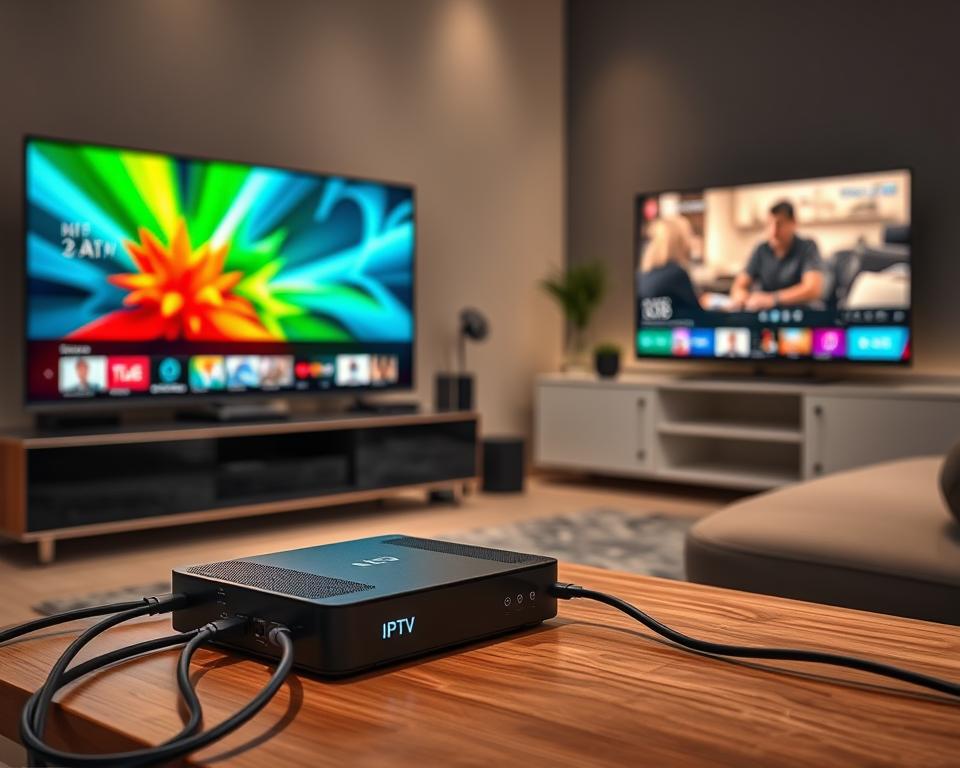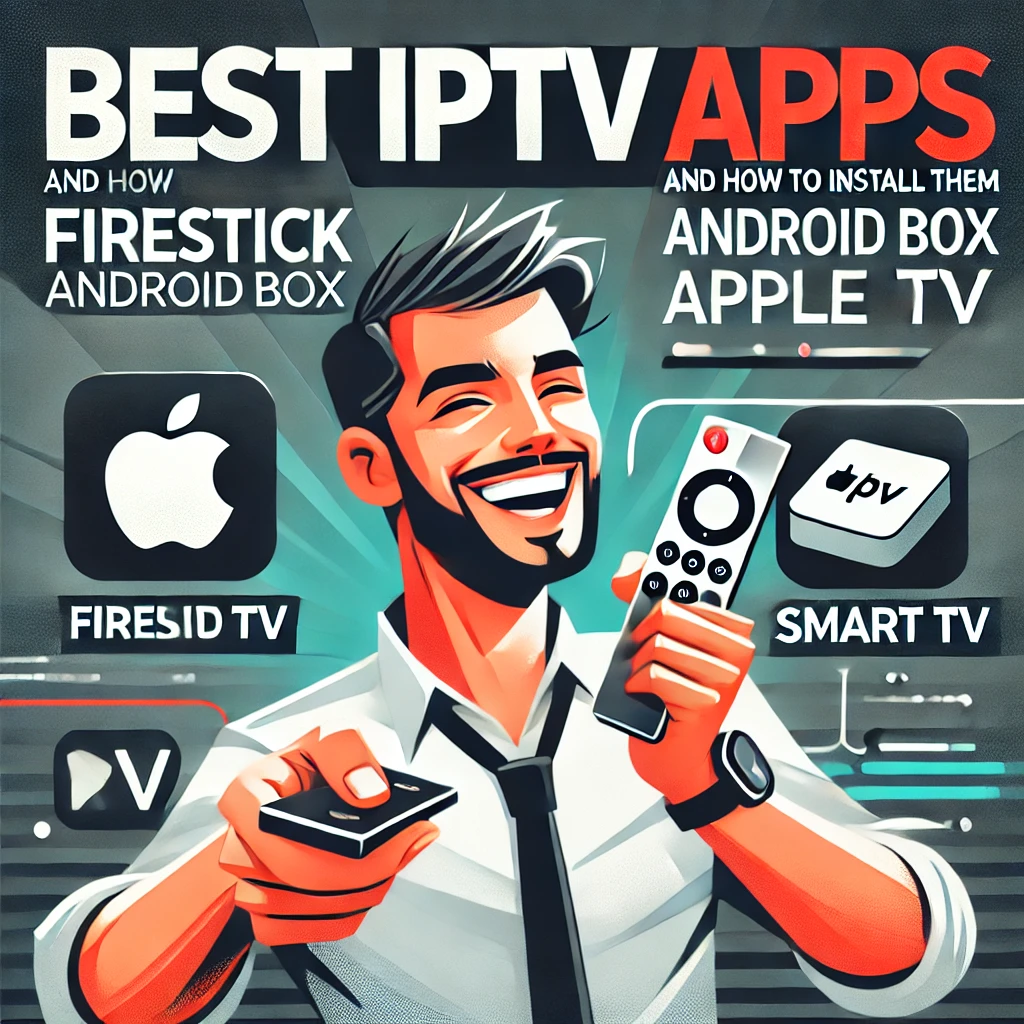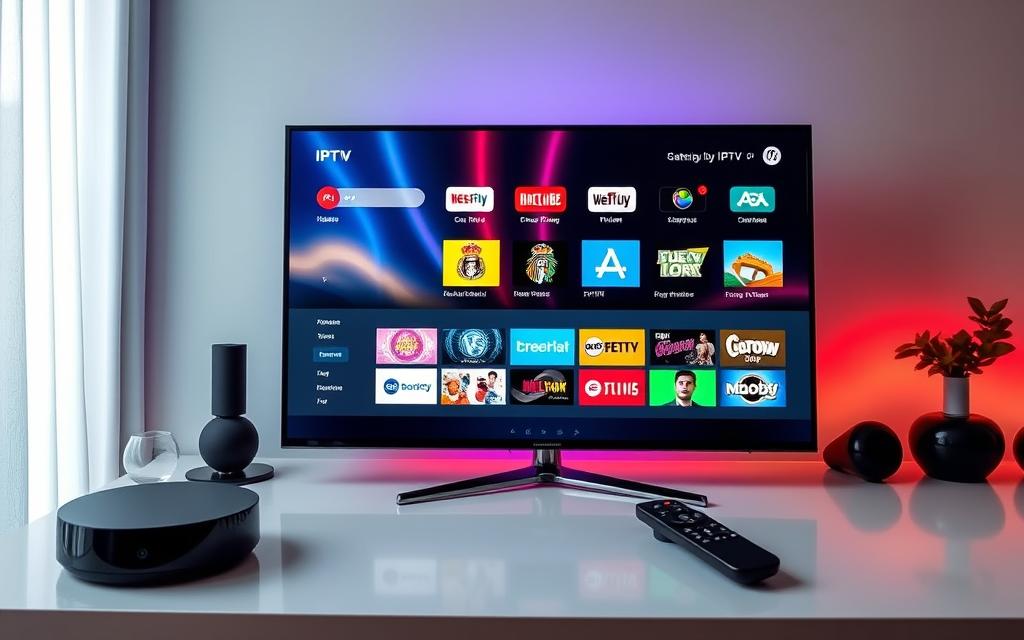Ever thought about boosting your entertainment by linking one IPTV box to multiple TVs? The world of media is changing fast, and now you can connect one IPTV box to 2 TVs. This not only makes watching more flexible but also helps save money. Imagine not worrying about high cable bills anymore. With IPTV, you get access to over 7,000 live channels from around the globe. Learn how to connect one IPTV box to 2 TVs and change the way you watch TV forever.
As streaming tech gets better, folks wonder how to hook up one IPTV box to two TVs. This guide will show easy steps to do that and tackle any problems you might face. Get ready to stream top-quality content no matter which room you’re in.
Key Takeaways
- Connecting one IPTV box to two TVs can significantly enhance your viewing experience and save on costs.
- IPTV provides access to more than 7,000 live channels, catering to various interests and preferences.
- Understanding the technical requirements is crucial for successful IPTV box setup and multiple TV connections.
- Various methods, including HDMI splitters and coaxial connections, facilitate sharing the IPTV signal across screens.
- Being aware of potential challenges, such as signal quality and device compatibility, is essential for a smooth setup.
Understanding IPTV and Its Benefits
IPTV stands for Internet Protocol Television. It delivers TV programming via internet networks, not the usual ways like cable. With this tech, you can watch live and on-demand shows on many devices such as TVs and smartphones. A big benefit of IPTV is its flexibility, which lets viewers enjoy their top picks on various platforms.
IPTV operates on both unicast and multicast technology. This means it can stream programs directly to one or many users at once. It brings extra perks like interactive TV and the power to watch what you want, when you want. Big names like Verizon, Netflix, and Hulu have made IPTV more popular by improving streaming.
IPTV can connect several TV sets to one subscription. This is a plus over normal cable, especially in smart homes today. As IPTV gets better and works with smart home tech, viewers will get a viewing experience that fits their likes more. For those looking into IPTV, guides on using IPTV Smarters Pro on Firestick can make setup easier and improve the experience.
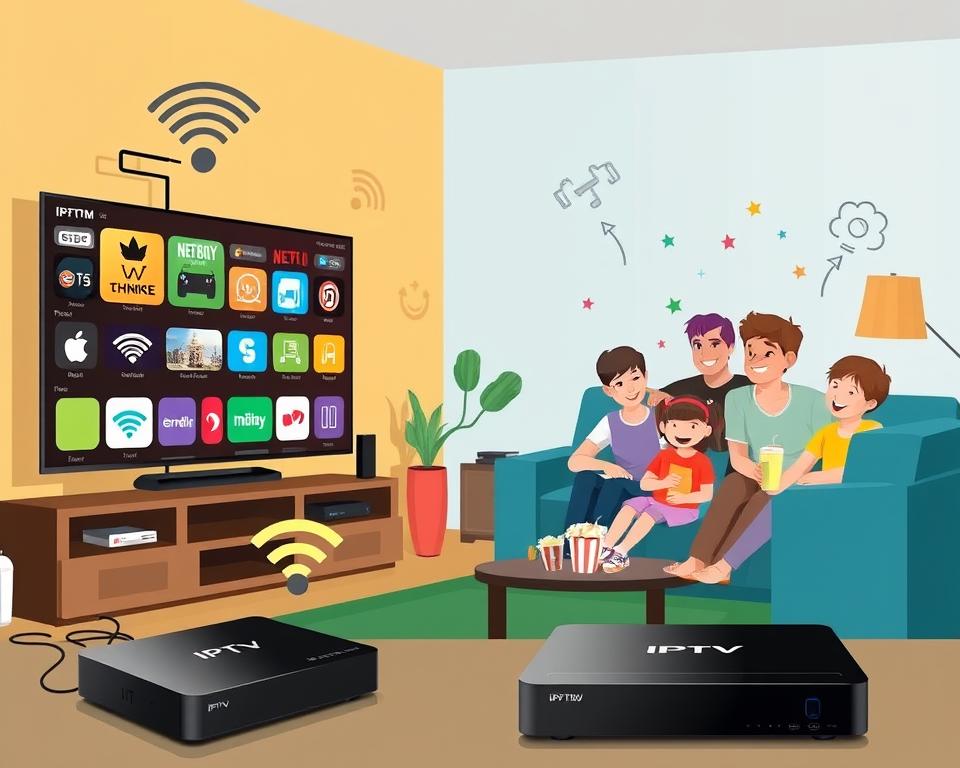
What Is an IPTV Box?
An IPTV box is like a magical media player for your TV. It grabs TV signals from the internet and turns them into shows you can watch. With an IPTV box, you can stream lots of services and channels right on your TV. They’re easy to set up with HDMI or AV cables and user-friendly to use.
There are many IPTV boxes out there, from simple ones to high-tech ones. Some well-known brands are MAG, Nvidia Shield, and Roku. They can play both HD and UHD videos. Also, they come with cool apps already installed to make watching better. These boxes meet different needs and offer cool features like video-on-demand and the option to pause and rewind shows.
IPTV boxes bring you tons of stuff to watch, like live sports, movies, and news from around the world. They are perfect for people who are always on the go. As tech gets better, you can even use wireless devices or phone apps to control your IPTV or send the signal to other TVs. Whether you get more IPTV boxes or devices to spread the signal depends on what you prefer and your budget.
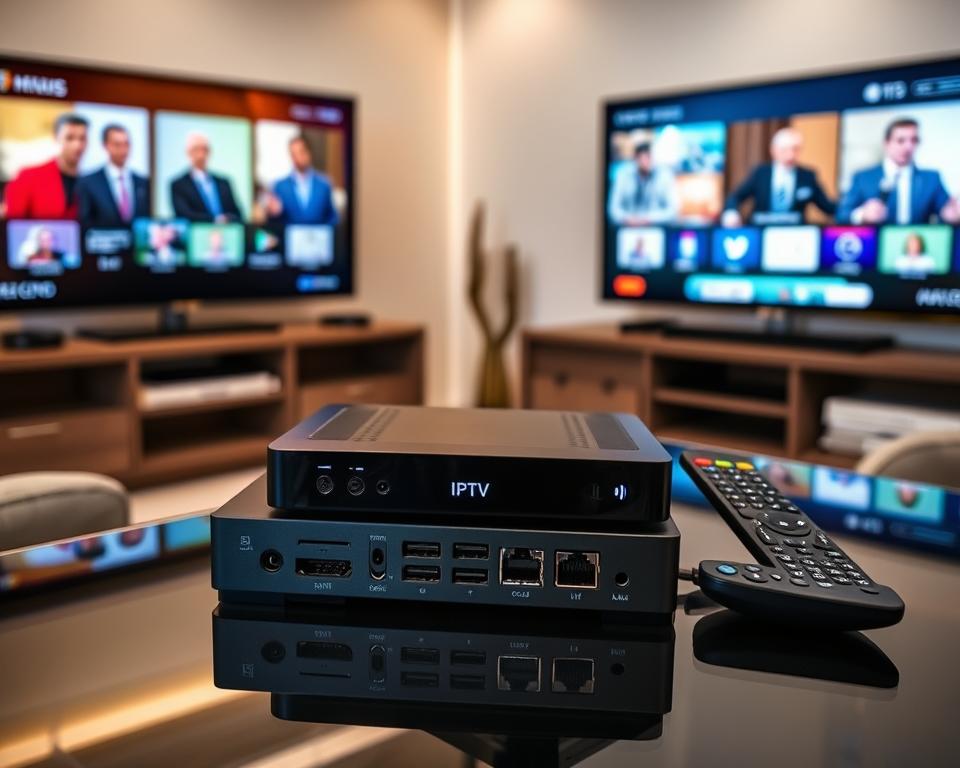
How to Connect One IPTV Box to 2 TVs
Linking your IPTV to more than one TV adds viewing freedom. For it to work well, you’ll need the right cables and adapters.
Requirements for Connection
To link one IPTV box to two TVs, make sure you have:
- One IPTV box
- HDMI cables or coaxial connections
- Adapters if needed
- HDMI splitter for two TVs
- TVs that work with the setup
Check your gear first to pick the best way to connect, considering your TVs and their features.
Common Connection Methods
Different ways to connect depend on your setup:
- HDMI Splitter: A popular choice for sending IPTV to two TVs. It streams one source to several screens.
- Coaxial Connections: Use an HDMI to coaxial kit for long distances. It reaches up to 600 feet without losing signal.
- S-Video Input: Old TVs might need this method. It shows some still use old tech.
- Wireless HDMI: This removes the mess of wires. Signals go to TVs within 100 feet wirelessly.
- IoT Smart Remotes: These control several screens at once. Great for big video walls at home or work.
Knowing these methods helps prepare for an easy, effective setup. It lets you get more from your IPTV.
Using an HDMI Splitter for Dual TV Connection
Connecting one IPTV box to two TVs is simple with an HDMI splitter. This device sends the same signal to multiple screens. It’s a handy way for a dual TV setup. The splitter’s quality is key for the best experience.
Choosing the Right HDMI Splitter
Picking the right HDMI splitter is vital. It must fit your need:
- Number of Output Ports: Make sure the splitter has enough ports.
- Support for High Resolutions: It should support 1080p or even 4K.
- Compatibility: It must work with your TVs.
Cost-effective HDMI splitters are often recommended. They have good signal quality. This makes them a go-to choice.
Step-by-Step Connection Guide
Here are the steps for setting up your HDMI splitter:
- Gather Required Equipment: Get your IPTV box, an HDMI splitter, and two HDMI cables.
- Connect the IPTV Box: Link one HDMI cable from the IPTV box to the splitter’s input.
- Attach to TVs: Use separate HDMI cables for each TV from the splitter’s outputs.
- Power On: Turn everything on to check the setup.
If there are problems, ensure both TVs are on. HDMI copy protection might interfere otherwise. Wireless HDMI extenders are good for sending signals up to 100 feet. This is helpful when thinking about layout and space.
Choosing the correct HDMI splitter and following these steps leads to an easy dual TV setup from one IPTV box.
Coaxial Connections for Multiple TVs
To get many TVs hooked up, coaxial cables are your best bet. They make sending the signal to each TV easy. By using splitters, you can connect several TVs to a single source. This setup is common in many homes and boosts the enjoyment of watching TV.
However, you need to watch out for signal loss. This happens when the cables get too long or you use too many splitters. If your TVs are far from the IPTV box, the picture might not be as clear. It’s all about finding the right balance to keep the picture looking good.
Picking top-notch cables and splitters is crucial. This ensures that every TV gets a strong signal. Some systems can support up to eight TVs, which is great for homes with lots of screens.
Below is a detailed comparison table of popular coaxial connection options for setting up IPTV across multiple screens:
| Connection Type | Max Connections | Signal Quality | Notes |
|---|---|---|---|
| Coaxial Splitters | 4-8 | Good to Excellent | Ideal for basic setups, check for attenuation. |
| Coaxial Amplifiers | Depends on model | Excellent | Necessary for long distances or multiple splitters. |
| Distribution Amplifiers | Varies | High | Takes in a signal and outputs to many TVs. |
Setting Up IPTV for Two TVs: Key Considerations
Setting up IPTV for two TVs involves unique challenges. It requires careful planning. Key factors like distance limitations and signal quality need attention for smooth viewing. Understanding these points helps create a strong setup.
Distance Limitations and Solutions
Distance can greatly impact IPTV’s performance and reliability. The further away a device is from the router, the more issues can arise. Long distances weaken signal strength and quality. To overcome this, using high-quality HDMI cables or extenders helps keep a strong connection. Also, wireless extenders improve signal over long distances. This ensures a better streaming experience on multiple TVs.
Signal Quality Issues to Watch Out For
Good signal quality is crucial when setting up IPTV for two TVs. Low internet speed can cause buffering and pixelation. A minimum internet speed of 10 Mbps for SD and 25 Mbps for HD is recommended for smooth streaming. To avoid playback errors, regularly update apps and devices. Using a wired connection also improves signal quality during peak times.
Using IR Remote Extenders
IR remote extenders are a great way to control your IPTV box from far away. They let you use the IPTV box even if you can’t see it. This is super handy for changing channels without moving. You don’t have to worry if your cable box is hidden behind the TV. The infrared light from the extenders can still reach it by bouncing off walls. Plus, they’re pretty cheap. Most people find they work well and only cost about $10.
However, not all IR remotes work well with every device. In discussions, all users mentioned having trouble with this. To fix this, 80% of them picked Harmony remotes. Others tried different solutions, like the nVidia Shield. Half of the users also placed their IR blasters strategically. This helped reduce problems.
Using IR remote extenders with stuff like RF modulators and wireless video senders is smart. It helps connect one IPTV box to several TVs smoothly. This setup is perfect when you can’t or don’t want to run cables across the room.
| Technology | Operating Distance | Common Issues Reported |
|---|---|---|
| Infrared (IR) | Effective when in line of sight | Compatibility issues and interference |
| Radio Frequency (RF) | Longer distances than IR | Less common, but some compatibility issues |
| Bluetooth | Up to 30 feet | Communication limitations |
Challenges in Connecting IPTV to Multiple Screens
Hooking up IPTV systems to many screens poses challenges in connecting IPTV to work through. A big obstacle is the HDMI copy protection rules. These stop unlawful content copying but can limit viewing on several TVs.
Addressing HDMI Copy Protection Issues
Dealing with HDMI copy protection can be tricky when sharing shows on different TVs. Users might see errors or blank screens if they try to split the signal without proper gear. It’s important to use HDCP-compliant devices and HDMI splitters. That way, the streamed content follows security standards, letting everyone enjoy the show on various screens.
Managing Different TV Types: HD and SD
Handling HD and SD TVs in one IPTV system brings another challenge. HD and SD TVs need different picture qualities, which can affect how shows look. You need at least 10 Mbps for SD and 25 Mbps for HD streaming. Also, HD TVs mostly need HDMI, while SD TVs use AV plugs. So, picking the right cables is key to good TV viewing.
It’s crucial for users to keep their gear updated and check their settings. This makes sure that different TVs work well together and reduces problems.
Using Dual Outputs from an IPTV Box
Using dual outputs from an IPTV box makes it work better, letting you stream smoothly on more than one TV. Most IPTV boxes come with HDMI and coaxial outputs. This lets you connect them to all kinds of TVs, both HD and SD.
Getting a HDMI splitter for dual outputs saves money. Many find that cheap splitters work as well as pricey ones for linking different screens. This means families can watch their top shows in various rooms without spending a lot.
When sending signals to two devices at once, keeping the signal strong is key. HDMI’s rules for copy protection can make streaming to two TVs hard, which might limit what you can do. Also, using the same cable for more than one output can weaken the signal. This shows why it’s important to know about cable types and their tech.
For setups that need to cover longer distances, using an HDMI to coaxial cable kit is helpful. It can run a coaxial cable as far as 600 feet. This is great for big houses where the IPTV box and TVs are far apart. Plus, looking into options like DISH’s Hopper 3 lets you mix streaming services with regular IPTV features, making watching TV even better.
As more TVs find their way into our homes, knowing about options like HDMI matrix switches is key. These tools let you handle many streams at once, ensuring you get a steady show on every TV.
| Output Type | Capabilities | Recommendation |
|---|---|---|
| HDMI | High definition streaming | Use for main TV |
| Coaxial | Long-distance transmission | Ideal for remote TVs |
| HDMI Splitter | Cost-effective dual output | Recommended for budget setups |
| HDMI Matrix Switch | Multiple input/output management | Best for complex setups |
Alternative Solutions for Sharing IPTV Signal
Looking into more ways than just one IPTV box offers chances for better and flexible watching. Getting more set-top boxes allows different channels on various TVs. This means family members can watch what they like at the same time. The Amazon Fire TV stick costs about $30. This makes it easier to have several, especially as more people choose Over The Air (OTA) options, which have gone up by 126%.
Using Multiple Set-Top Boxes
Using many set-top boxes means each screen can show different things. The Fire TV Recast, for instance, can connect to up to seven TVs. This setup lets the whole family watch various shows together but on different screens. This device is about $270. Given how it meets different watching needs, it’s quite affordable. Plus, most users like Amazon’s gear because there’s no monthly fees, with 72% choosing them over others.
Exploring Multi-Screen Viewing Options
Combining coaxial and HDMI outputs brings more ways to share IPTV signals to several TVs. These systems allow seamless viewing across all screens, thanks to IPTV’s multicast capability. HDMI splitters can connect even up to 16 screens. But it’s important to set it up right to keep the signal good. Using IR signal extenders, you can control the set-top boxes from any room.
Installation Tips for a Smooth IPTV Experience
For a great IPTV setup, follow these important tips. Make sure your IPTV box is in the middle of your space for a strong signal. Keep it away from microwaves or cordless phones to avoid signal problems.
Organize your cables well to improve the setup. Use ties or sleeves to keep wires neat and avoid messing up. This makes your setup look good and helps find any signal issues faster.
Choose an IPTV box that works well with what you already have. Some top choices are the Amazon Fire TV Stick, NVIDIA Shield TV, and Apple TV 4K. Each has special features for different preferences. Make sure you have fast internet—at least 5 Mbps for regular videos and 25 Mbps for HD.
After setting up, adjust the interface to what you like. Learn how to change the settings for better speed and quality. A bit of effort in setting things up can greatly improve your IPTV watching.
Common Mistakes When Setting Up
When setting up an IPTV box, people often make mistakes that cause problems. One common mistake is using the wrong types of cables. These might not be able to handle the bandwidth needed for high-quality streaming. Also, setting up VLAN settings wrong is a frequent issue. People are advised to use VLAN IDs 18 or 27, but sometimes, finding the right one among over 4,000 options is necessary for smooth operation.
Another overlooked step is the importance of using the correct TV port for MAC address registration on the router. This step is key for the set-top box to be recognized by the ISP’s network. If skipped, it could lead to connectivity issues. Configuring a network port in TV port mode is crucial for managing this connection well. Also, failing to provide enough power during setup can disrupt service, as devices might not work correctly if they’re underpowered.
Many users wrongly think that their firewalls or antivirus won’t affect IPTV performance. Yet, such software can block crucial multicast traffic, causing further IPTV setup mistakes. Lastly, skipping post-installation checks, like signal quality verification and a full router restart, can hinder a successful setup and the viewing experience.
Testing and Troubleshooting Your Connection
Making sure your IPTV works well means testing and fixing your connection. This helps check the signal and find issues that might hurt your streaming.
Verifying Signal Quality
First, we check the signal quality of IPTV connections. A good and steady internet is key because bad signal means interruptions and other problems. Make sure your IPTV device is hooked up and on.
Also, look for errors or updates in your TV guide. These issues might mean a bad connection. You might see bad picture quality or streaming might stop and start.
Steps to Take if Issues Arise
If you run into problems, here’s how to fix them step by step:
- First, make sure your internet works well. A stable connection with enough speed is needed.
- Then, reboot your IPTV device. This updates it and fixes small problems.
- Make sure all wires and connections are good. This can solve a lot of issues.
- If you still have trouble, update the TV guide data. This fixes problems with old or wrong data, letting your device get new info.
- If you can’t fix it, call your IPTV provider. They can help figure out the issue and fix signal problems.
Conclusion
Linking one IPTV box to two TVs can make your watching experience much better. You can use HDMI splitters or coaxial cables to do this. HDMI splitters let you link to several screens, from just two up to 16. Coaxial cables can connect to up to 6 TVs. But, long cables might lower the signal quality.
Choosing the right IPTV box, like Nvidia Shield or Formuler Z8, is key for good performance. Adding a VPN also helps keep your streaming smooth and your info private. With the right planning and gadgets, you can enjoy a great setup for watching on multiple TVs.
By following these tips, you can watch your top shows smoothly on several TVs. Explore the full potential of your IPTV service and boost your home’s fun factor.

